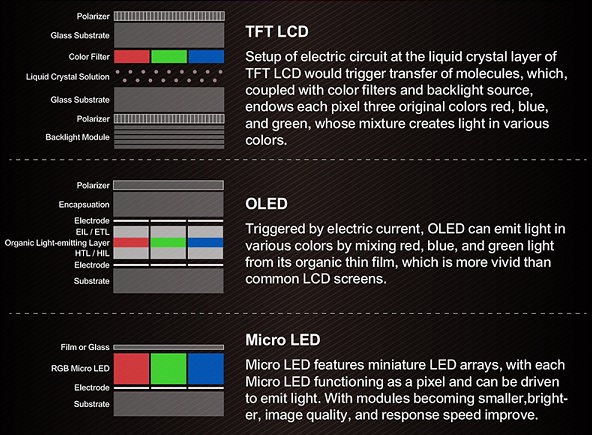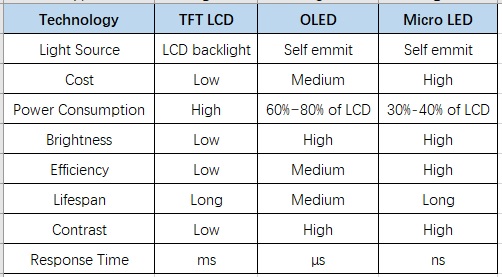Comparison - TFT LCD vs OLED vs Micro LED
TFT LCD is a mature technology. OLED is a relatively new display technology, being used in more and more applications. As for Micro LED, it is a new generation technology with very promising future. Followings are the pros and cons of each display technology.

TFT LCD
TFT Liquid Crystal Display is widely used these days. Since LCD itself doesn't emit light. TFT LCD relies on white LED backlight to show content. This is an explanation of how TFT LCD works.
Pros
- Low cost & long lifespan: LCD is mature technology. Comparing with OLED, it has longer life time.
- No stroboscopic effect: LCD uses DC power white LED backlight. Which won't produce stroboscopic effect.
- High pixel density:Under the same resolution, TFT LCD produces sharper image than OLED.
Cons
- High power consumption:TFT LCD needs backlight. So it is thicker and consumes more power.
- Relatively lower contrast:Light needs to pass through LCD glasses, liquid crystal layer, polarizers and color filters. Over 90% is lost. Also, LCD can not display pure black.
OLED
Organic Light-Emitting Diode is built from an electro-luminescent layer that contains organic compounds, which emit light in response to an electric current. There are two types of OLED, Passive Matrix OLED (PMOLED) and Active Matrix OLED (AMOLED). These driving methods are similar to LCD's. PMOLED is controlled sequentially using a matrix addressing scheme, m + n control signals are required to address a m x n display. AMOLED uses a TFT backplane that can switch individual pixels on and off.
Pros
- Due to its light emitting characteristic, OLED is thinner and lighter than LCD.
- Low power consumption and flexible: OLED doesn't rely on backlight and consumes less power. OLED is essentially created on plastic film. It is bendable and easy to process.
- High contrast and vivid color: OLED emits light itself, can produce very bright image with beautiful color. And because OLED can be turned off, it can produce true black.
- Turning LED on and off is faster than liquid crystal twisting, OLED's response time is shorter than LCD.
Cons
- OLED could have image retention (burn-in) problem. It is gradual degradation of pixels, after showing static image for a long period of time.
- Stroboscopic effect: most OLED screen uses PWM dimming technology. Some people who are easy perceive stroboscopic frequency may have sore eyes and tears.
- Organic material that produces blue light has shorter life time. This leads to OLED color shifting and shorter lifespan.
Micro LED
Micro LED, sometimes called μLED is made up of tiny LED, measure less than 100μm. Another way of looking at this is that MicroLEDs are simply traditional LEDs shrunk down and placed into an array.
Pros
- Comparing with TFT LCD and OLED, Micro LED has very fast response time, high brightness, wide viewing angle and long lifespan.
- Replacing organic material with inorganic GaN material eliminates the need of polarizing and encapsulation layer, found in OLED. Micro LED is smaller and thinner, consumes less power.
Cons
- Expensive: Micro LED is a new technology, expensive to make.
- Difficult to produce: As all new technologies, manufacturing Micro LED is facing many difficulties at the moment.

